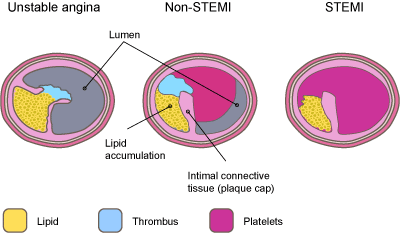Cardiology Teaching Package
A Beginners Guide to Normal Heart Function, Sinus Rhythm & Common Cardiac Arrhythmias
What is Happening within the Arteries
Below, the picture shows three outcomes of plaque rupture, the commonest of which is unstable angina which you will come across on any ward you work on.
Image: Acute Coronary Syndromes

In unstable angina, blood is still flowing through the narrowed artery and, when the patient is at rest, there is often enough blood and oxygen getting through to serve the needs of the heart. However, when the patient exerts themselves the heart has to work harder and therefore needs more oxygen. At this point there is not enough oxygen getting through the narrowed artery to serve the needs of the heart and it becomes ischaemic.
Depolarisation of the chambers of the heart continues as normal but when the electrical stimulus reaches the ischaemic tissue it finds it difficult to pass through and the ECG machine picks up this problem as ST depression or T wave changes. (see earlier examples)
